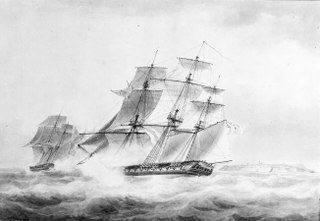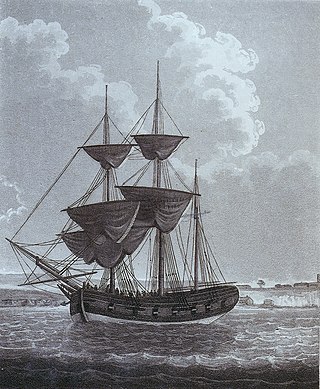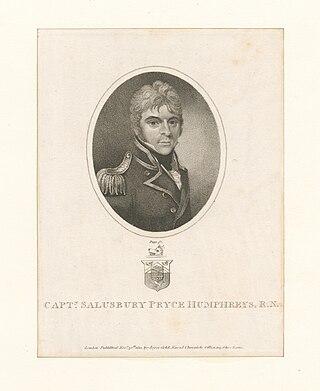HMS Leda, launched in 1800, was the lead ship of a successful class of forty-seven British Royal Navy 38-gun sailing frigates. Leda's design was based on the French Hébé, which the British had captured in 1782. Leda was wrecked at the mouth of Milford Haven in 1808, Captain Honeyman was exonerated of all blame, as it was a pilot error.

HMS Phoenix was a 36-gun Perseverance-class fifth-rate frigate of the Royal Navy. The shipbuilder George Parsons built her at Bursledon and launched her on 15 July 1783. She served in the French Revolutionary and Napoleonic Wars and was instrumental in the events leading up to the battle of Trafalgar. Phoenix was involved in several single-ship actions, the most notable occurring on 10 August 1805 when she captured the French frigate Didon, which was more heavily armed than her. She was wrecked, without loss of life, off Smyrna in 1816.
Launched on 21 May 1797, GB No. 21 was renamed HMS Defender on 7 August the same year. She was a 12-gun Courser-class gun-brig built for the British Royal Navy at Limehouse and disposed of in 1802.

Pomone was a 40-gun frigate of the French Navy, launched in 1785. The British captured her off the Île de Batz in April 1794 and incorporated her into the Royal Navy. Pomone subsequently had a relatively brief but active career in the British Navy off the Atlantic and Mediterranean coasts of France before suffering sufficient damage from hitting a rock. Due to this, the ship was taken out of service and then broken up in 1803.

HMS Juno was a Royal Navy 32-gun Amazon-class fifth rate. This frigate served during the American War of Independence, and the French Revolutionary and Napoleonic Wars.
Captain Adam Mackenzie was an officer of the British Royal Navy who served during the American, French Revolutionary and Napoleonic Wars, being present at numerous fleet actions, as well as serving as successful ship captain.

HMS Wolverine, was a Royal Navy 14-gun brig-sloop, formerly the civilian collier Rattler that the Admiralty purchased in 1798 and converted into a brig sloop, but armed experimentally. She served during the French Revolutionary Wars and participated in one action that won for her crew a clasp to the Naval General Service Medal. A French privateer captured and sank Wolverine on 21 March 1804 whilst she was on convoy duty.
His Majesty's hired armed cutter Courier appears twice in the records of the British Royal Navy. The size and armament suggests that both contracts could represent the same vessel, but other information indicates that the second Courier had been captured from the French in the West Indies. On the first contract the captain and crew were awarded clasps to the Naval General Service Medal, one for a boat action and one for a single ship action in which they distinguished themselves.

HMS Cruizer was a Royal Navy Cruizer-class brig-sloop built by Stephen Teague of Ipswich and launched in 1797. She was the first ship of the class, but there was a gap of 5 years between her launch and the ordering of the next batch in October 1803; by 1815 a total of 105 other vessels had been ordered to her design. She had an eventful wartime career, mostly in the North Sea, English Channel and the Baltic, and captured some 15 privateers and warships, and many merchant vessels. She also participated in several actions. She was laid up in 1813 and the Commissioners of the Navy sold her for breaking in 1819.

HMS Peterel was a 16-gun Pylades-class ship-sloop of the Royal Navy. She was launched in 1794 and was in active service until 1811. Her most famous action was the capture of the French brig Ligurienne when shortly after Peterel captured two merchant ships and sent them off with prize crews, three French ships attacked her. She drove two on shore and captured the largest, the 14-gun Ligurienne. The Navy converted Peterel to a receiving ship at Plymouth in 1811 and sold her in 1827.

Sir Salusbury Pryce Humphreys, later called Salusbury Pryce Davenport, was an officer of the Royal Navy who saw service during the French Revolutionary and Napoleonic Wars and the War of 1812, rising to the rank of rear admiral.

HMS Circe was a 28-gun Enterprise-class sixth-rate frigate of the Royal Navy. She was launched in 1785 but not completed or commissioned until 1790. She then served in the English Channel on the blockade of French ports before she was wrecked in 1803.

HMS Harpy was a Royal Navy Diligence-class brig-sloop, launched in 1796 and sold in 1817. She was the longest lived vessel of her class, and the most widely travelled. She served in both the battle of Copenhagen and the British invasion of Java, took part in several actions, one of which won for her crew a clasp to the Naval General Service Medal, and captured numerous privateers. The Navy sold her in 1817.
Two vessels named His Majesty's hired armed cutter Griffin served the British Royal Navy, the first during the French Revolutionary Wars and the second during the Napoleonic Wars. The descriptions of the two Griffins are similar enough to suggest they may have been the same vessel.
Jalouse was an 18-gun Belliqueuse-class brig-corvette of the French Navy, built to a design by Pierre-Alexandre-Laurent Forfait, and launched in 1794 at Honfleur. The Royal Navy captured her in May 1797 and took her into service under her existing name. In British service she served primarily on the North Sea station where she captured three small French privateers, and many Dutch merchant vessels. She also participated with other British warships in two or three major cutting-out expeditions. She was broken up in 1807.
HMS Stag was a 32-gun fifth-rate frigate built for the Royal Navy. She was ordered in 1790 and work began in March 1792 at Chatham Docks. Completed in August 1794, Stag spent much of her service in home waters, where she worked to protect British shipping from French privateers. In an action on 22 August 1795, Stag engaged, and forced the surrender of, the Dutch frigate Alliante, and took part in the chase that ended with the capture of Bonne Citoyenne by HMS Phaeton on 10 March 1796.
HMS Growler was a Courser-class gun-brig built for the British Royal Navy at Northfleet and launched in 1797 as GB No. 26; she was renamed Growler on 7 August the same year.
HMS Cracker was an Acute-class gunbrig, launched in 1797. She was sold in 1802.

HMS Tickler was launched in August 1808 at Brightlingsea as a later Archer-class gunbrig. She served in the Channel and the Baltic until the Danes captured her in 1808 during the Gunboat War. They sold her in 1815. From 1815 to 1852 she sailed as Frederikke Louise, first as a merchantman and then from 1843 to 1851 as a sealer.









